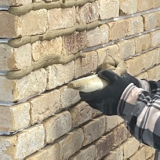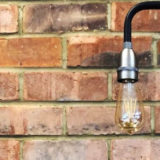Brick slip feature walls have revolutionized interior and exterior design by providing a stylish, versatile, and cost-effective alternative to traditional brick walls.
These thin slices of brick retain the visual appeal of full bricks while being lighter and easier to install. Brick slip feature walls are increasingly popular in residential, commercial, and even outdoor settings, thanks to their aesthetic charm and practical benefits.
History of Brick Slip Feature Walls
Ancient Use of Brick
The use of brick dates back thousands of years, with ancient civilizations such as the Egyptians, Mesopotamians, and Romans utilising bricks in construction. These early bricks were made from mud and straw, baked in the sun to create sturdy building materials.
Development of Brick Slips
Brick slips, as a modern adaptation, emerged as a practical solution for achieving the look of a brick wall without the associated weight and cost. They gained popularity in the 20th century, particularly in urban renovations where preserving space and structural integrity was crucial.
Types of Brick Slip Feature Walls
Natural Brick Slips
Natural brick slips are made by slicing full bricks into thinner pieces. These slips retain the unique textures and colors of traditional bricks, offering an authentic appearance. They are durable and weather-resistant but can be more expensive and heavier than other types.
Reclaimed Brick Slips
Reclaimed brick slips are sourced from old buildings and structures, giving them a unique, aged look. They are environmentally friendly, promoting recycling and sustainability. These slips often carry historical significance and add a rustic charm to any space.
Manufactured Brick Slips
Manufactured brick slips are produced using molds and modern materials, such as concrete or resin. These slips can mimic the appearance of natural bricks and come in various colors and textures. They are typically more affordable and lighter than natural brick slips.
Installation Techniques
Preparing the Wall
Proper preparation is key to a successful brick slip installation. This includes cleaning the wall surface, repairing any damage, and applying a primer to ensure the adhesive bonds well. It’s also important to measure and plan the layout to avoid mistakes during installation.
Applying Adhesive
The adhesive used for brick slips must be suitable for the wall type and environment. High-quality tile adhesive or our specialised rapid set brick slip adhesive is recommended. The adhesive should be applied evenly using a notched trowel to ensure strong adhesion.
Fixing the Slips
Brick slips should be pressed firmly into the adhesive, starting from the bottom and working upwards. It’s essential to maintain even spacing between the slips, using spacers if necessary. This step requires precision to achieve a uniform appearance.
Grouting and Finishing
Once the adhesive has set, the gaps between the slips can be filled with grout. The grout should be applied carefully to avoid staining the brick surfaces. After grouting, any excess should be cleaned off, and the wall should be sealed to protect against moisture and dirt.
Benefits of Brick Slip Feature Walls
Aesthetic Appeal
Brick slip feature walls add a unique and timeless aesthetic to any space. They can be used to create focal points, accent walls, or entire room designs. The variety of colors, textures, and patterns available allows for endless design possibilities.
Durability and Longevity
Brick slips are known for their durability and longevity. They are resistant to wear and tear, making them an excellent choice for high-traffic areas. When properly installed and maintained, brick slip feature walls can last for decades.
Cost-Effectiveness
Compared to traditional brick walls, brick slips are more cost-effective due to reduced material and labor costs. They provide the same visual impact at a fraction of the price, making them an attractive option for budget-conscious homeowners and businesses.
Thermal Insulation
Brick slips offer good thermal insulation properties, helping to maintain a stable indoor temperature. This can lead to energy savings and increased comfort, especially in older buildings where insulation may be lacking.
Common Applications
Residential Spaces
In homes, brick slip feature walls can be used in living rooms, kitchens, bedrooms, and bathrooms. Brick Slips add character and warmth to any room, creating a cozy and inviting atmosphere.
Commercial Spaces
In commercial settings, brick slip feature walls are popular in retail stores, restaurants, cafes, and offices. They enhance the ambiance, create a memorable customer experience, and can even improve brand identity.
Outdoor Use
Brick slips are also suitable for outdoor applications, such as garden walls, outdoor kitchens, and patios. Their weather-resistant properties make them an excellent choice for exterior design projects.
Maintenance and Care
Routine Cleaning
Regular cleaning helps maintain the appearance of brick slip feature walls. A soft brush or vacuum can be used to remove dust and dirt. For deeper cleaning, a mild detergent and water solution can be applied, followed by rinsing with clean water.
Repairs and Touch-Ups
Minor damages, such as chips or cracks, can be repaired using a matching adhesive or filler. For more significant damage, it’s advisable to consult a professional to ensure the repairs are done correctly.
Expert Insights
Architects’ Perspectives
Renowned architect Jane emphasizes the versatility of brick slips in modern architecture.
“Brick slips offer the perfect balance between aesthetic appeal and practicality. They can be used in various applications, from interior feature walls to exterior facades, providing a timeless look.”
Interior Designers’ Tips
Interior designer John suggests using brick slips to create a statement wall in living rooms or kitchens.
“Brick slips can transform a plain wall into a stunning focal point. They work well with various design styles and add a touch of elegance and warmth to any space.”
Conclusion
Brick slip feature walls are a versatile, cost-effective, and aesthetically pleasing solution for enhancing both interior and exterior spaces. Their numerous benefits, from durability to thermal insulation, make them a popular choice in contemporary design.
By understanding the different types, installation techniques, and maintenance tips, homeowners and designers can successfully incorporate brick slips into their projects, creating beautiful and lasting feature walls.






































